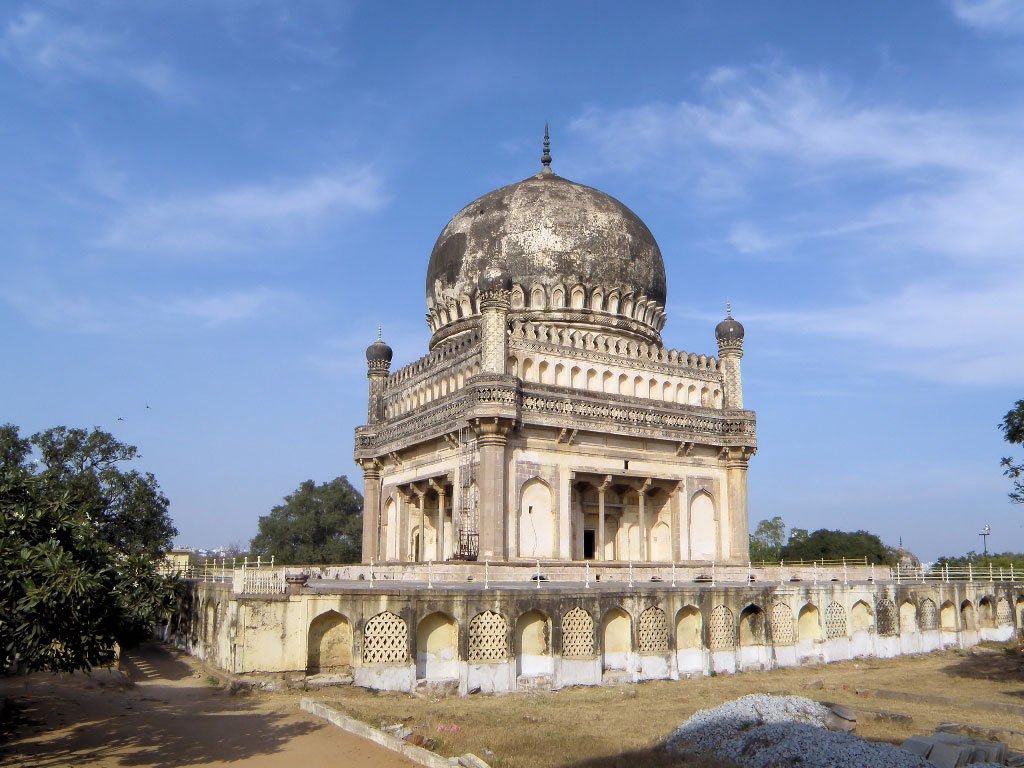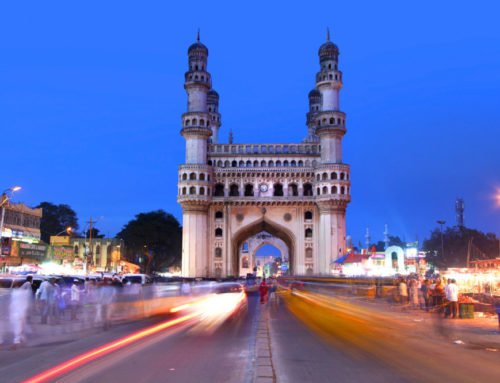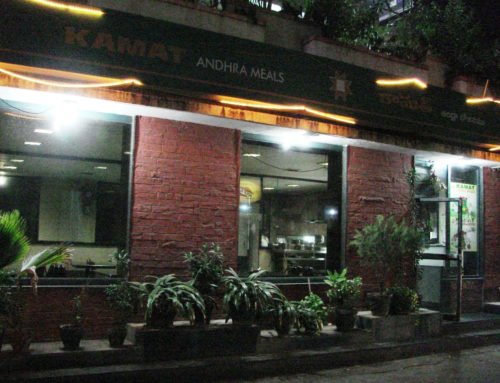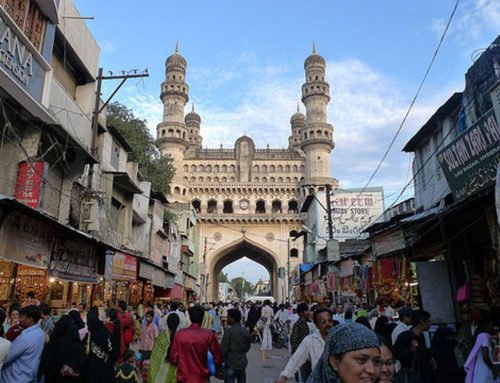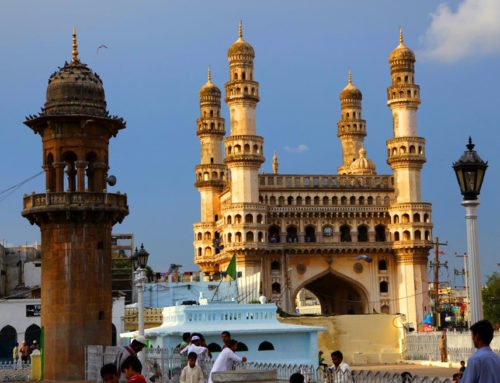Overview
- Features: Mausoleums of seven Qutub Shahi rulers of Hyderabad
- Opening Times: 9am to 5pm, daily
- Best Time to Visit: Late October to early March
- Duration: 30 mins to 1 hour
- Travelled By: Bus, Foot
- Cost: Rs 10
- Address: Fort Road, Towli Chowki, Hyderabad, Andhra Pradesh, India
- Type: Shrine
Author Reviews[display_rating_item_results rating_form_id=”2″ rating_entry_ids=”1″ show_category_filter=”false” show_options=”true” result_type=”star_rating” preserve_max_rating=”true” show_title=”false” show_count=”false” ]
Total Rating: [display_rating_result rating_form_id=”2″ show_count=”false” show_rich_snippets=true] [accordions load=”1″] [accordion title=”User Reviews” last] [display_rating_item_results rating_form_id=”5″ show_options=”true” result_type=”star_rating” preserve_max_rating=”true” show_title=”false” show_count=”true” show_rich_snippets=true] [/accordion] [accordion title=”Add Review”][display_rating_form show_email_input=”true” show_comment_textarea=”true” show_name_input=”true” rating_form_id=”5″] [/accordion] [/accordions]
Summary
About 1.5km (160 miles) northwest of Golconda Fort’s Balahisar Gate, lies the graceful domed Qutub Shahi tombs. This royal necropolis with intricately carved stonework is laid out in gardens with water channels, pools and tree-lined pathways. Among the mausoleums, Mohammad Quli Qutub Shahi is the most impressive. Also worth a visit are the tombs of Hayat Bakshi Begum and Abdullah Qutub Shah (VII ruler), the Great Mosque and the Badshahi Hammam.
Qutub Shahi Tombs Hyderabad
About 1.5km (160 miles) northwest of Golconda Fort’s Balahisar Gate, lies the graceful domed Qutub Shahi tombs of the erstwhile rulers. Seven of the nine Qutub Shahi rulers were buried here, as well as members of the royal family and respected citizens from entertainers to doctors. This royal necropolis with intricately carved stonework is laid out in gardens with water channels, pools and tree-lined pathways. The tomb-garden of the sultans of Golconda was known as Lagar-e-Faiz Athar (a place for bountiful entertainment) in the days of the Qutub Shahi rulers, for some item or song or dance or even an occasional play was staged here every evening, free of cost, to entertain the poor.
[singlepic id=1835 w=720 h=560 float=center]
The tombs display a distinct and eclectic architectural style – they have large onion domes, Persian arches, Turkish columns and Hindu brackets and motifs. Built of grey granite and plaster, each tomb’s dome is set on a square or octagonal petalled base, with a richly ornamented gallery and small minarets surrounding it.
The tombs were once furnished with carpets, chandeliers and velvet canopies on silver poles. Copies of the Quran were kept on pedestals and readers recited verses from the holy book at regular intervals. Golden spires were fitted over the tombs of the sultans to distinguish their tombs from those of other members of the royal family.
The tombs of the rulers were built under their own supervision. During the Qutub Shahi period, these tombs were held in great veneration. But after their reign, the tombs were neglected until Sir Salar Jung III ordered their restoration in the early 19th century. A garden was laid out, and a compound wall was built. Once again, the tomb-garden of the Qutub Shahi family became a place of serene beauty. It is now managed and kept in an excellent state of repair by the Archaeological Survey of India. The gardens are being further improved. All except the last of the Qutub Shahi sultans lie buried here.
Tomb of Abdullah Qutub Shah
[singlepic id=1836 w=720 h=560 float=center]
The road north from Golconda fort passes the tomb of Abdullah Qutub Shah (1626- 1672) as it approaches the entrance to the tombs, which is at the east gate of the compound. The tomb is built over a spacious square platform, a replica of the tomb of his parents, Mohammad Qutub Shah and Hayt Bakshi Begum. It is the largest structure in the entire complex. The main improvement in the structure is the treatment of the roof of the arcaded veranda, which is adorned with a cornice on brackets and a parapet of merlons of an elaborated trefoil pattern, slender minarets of proportionate height with one gallery. The upper storey is elevated by adding a rectangular jallies below the trefoiled parapet. Features like surface decorations, particular the corner minarets and the double cornices have made this tomb architecturally superior to the other two tombs.
[singlepic id=1827 w=720 h=560 float=center]
[singlepic id=1829 w=720 h=560 float=center]
Traces of encaustic tiles are seen on its south-west minaret. The original grave can be approached through an arched passage from the southern side of the basement under the staircase.
[singlepic id=1824 w=720 h=560 float=center]
Tomb of Mohammad Quli Qutub Shah
[singlepic id=1825 w=720 h=560 float=center]
The tomb of Mohammad Quli Qutub Shah (ruled 1581-1612), the poet king and founder of the city of Hyderabad, is the most impressive. It is appropriate that the man responsible for creating a number of beautiful buildings in Hyderabad should be commemorated by such a remarkable tomb. Built in 1602 A.D., it is surrounded by a spacious terrace, where poetry and music festivals are occasionally held.
[singlepic id=1832 w=720 h=560 float=center]
[singlepic id=1821 w=720 h=560 float=center]
The sides of the tomb have inscriptions in beautiful Persian and Naksh scripts and traces of brilliant turquoise and green enamelled tiles, which once covered the façades of all the tombs, still remain. There are entrances on the southern and eastern sides; a flight of steps leads to the mausoleum proper. The underground excavations here have been turned into a Summer House.
[singlepic id=1822 w=720 h=560 float=center]
Tomb of Queen Hayat Bakshi Begum
[singlepic id=1828 w=720 h=560 float=center]
Other remarkable monuments are the Tomb of Queen Hayat Bakshi Begum, the wife of Mohammad Quli Qutub Shah, and the mosque behind it (both mid-17th century), decorated with exquisite floral designs and calligraphy.
Hayat Bakshi Begum was the daughter of Mohammad Quli Qutub Shahi (fifth Qutub Shahi king), the wife of Sultan Mohammad Qutub Shah (sixth Qutub Shahi king) and mother of Abdullah Qutub Shah (seventh Qutub Shahi king). She was affectionately known as “Ma Saheba” (Revered Mother). Her tomb is similar to that of her husband in its architectural composition and decoration. The tomb has a square chamber surrounded by a spacious gallery of seven arched openings at each side over a square platform. The upper storey has five arches deeply recessed on each side and octagonal buttresses at each corner. They are decorated with the usual parapet and small domical finials at each end as well as above the arch tiers along the parapet. This tomb rises in the form of a pyramid and represents a break from the traditional square type. The design of the interior also shows a departure by constructing the walls of the square chamber skilfully in the form of wide massive arches by using triangular pendents and resting the domical ceiling on them.
[singlepic id=1823 w=720 h=560 float=center]
Great Mosque
[singlepic id=1819 w=720 h=560 float=center]
The Qutub Shahis built a number of masjids (mosques) all over Golconda and Hyderabad, and almost every tomb has a masjid adjacent. The biggest and the grandest such masjid is located beside the mausoleum of Hayat Bakshi Begum. Popularly known as the great masjid (Great Mosque) of the Golconda tombs, it was built in 1666 A.D. during the reign of Abdullah Qutub Shah. The prayer hall is three bays deep and has a five arched arcade with pointed arches and substantial columns. Fifteen cupolas decorate the roof and the prayer-hall is flanked by two lofty minarets. The minarets and stucco decoration are the chief architectural features of the mosque. The impression, as a whole, is one of majesty and splendour. The inscription in the prayer niche is carved in the best Thuith and Taudi styles of calligraphic art. Translation of the two inscriptions on the façade read as “Hasten to say your prayers lest ye miss them” and “Hasten to repent lest ye perish”.
[singlepic id=1820 w=720 h=560 float=center]
Badshahi Hammam
[singlepic id=1839 w=720 h=560 float=center]
At the centre of the complex is the simple but beautiful proportioned Badshahi Hammam. The Badshahi Hammam, which stands opposite the tomb of Muhammad Quli, was built by Sultan Quli. The oldest structure in the compound, it is a royal mortuary bath where the bodies of the deceased kings were ritually bathed before burial on the inlaid, 12-sided platform. You can still see the channels for the water and the special platforms for washing the body. The Badshahi kings were Shia Muslims, and the 12 small baths in the Hammam stand symbolically for the twelve imams revered by the Shi’a community.
Next door, a small Archaeological Museum has interesting items in glass cases.
Bhagmati, the wife of Muhammad Quli Qutub Shah after whom the city of Hyderabad was supposedly named, died in 1611 CE. Mir Momin, the Peshwa (Prime Minister) of Mohammed Quli did not appreciate the closeness between the Sultan and Bhagmati. Therefore, he decided to ensure that Bhagmati’s character is driven out of contemporary history, so much so that she did not even have a tomb built over her last remains.
Getting to & from Qutub Shahi Tombs
Qutub Shahi tombs are located in Golconda 13 km (7 miles) from Hyderabad so the best option is to visit this attraction either before or after Golconda Fort.
The most affordable way is to take a bus from Abids or another area of Hyderabad to Golconda Fort. There are several buses that leave regularly from the main bus station in the Abids area. After visiting the fort, get an auto rickshaw to drop you in front of Qutub Shahi tombs 1.5 km (1640 yards) away.
Alternatively, you can take an auto rickshaw or taxi with a meter the entire way from Hyderabad which will drop you right in front of the tombs.
Of course, you can also hire a private car with chauffeur who will wait for you in the parking area in front of the tombs. When booking your private car always ensure you are using a reputable hotel or travel agency.


